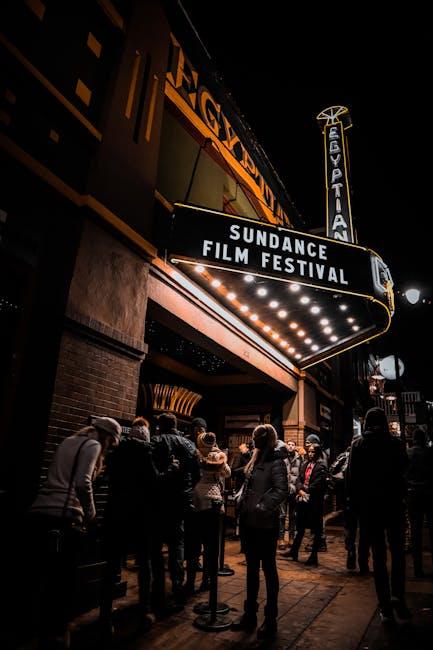In the dimly lit theaters and bustling auditoriums where the magic of cinema unfolds, film festivals stand as grand celebrations of storytelling. These events, draped in glamour and prestige, promise to spotlight the brightest and boldest voices in filmmaking. Yet, beneath the glittering veneer lies a question that provokes both curiosity and controversy: Are film festivals inherently biased in favor of established filmmakers? This inquiry invites us to explore the intricate dynamics of recognition and opportunity within the cinematic world. As we delve into this topic, we unravel the threads of tradition and innovation, seeking to understand whether the red carpet truly welcomes all, or if its embrace is reserved for those already adorned with laurels.
Navigating the Festival Landscape: Opportunities and Challenges for New Voices
- Opportunities for Emerging Talent: Film festivals offer a platform for fresh voices to showcase their work to an international audience. These events can serve as a launchpad, providing visibility and networking opportunities with industry professionals. Many festivals have dedicated sections for new filmmakers, offering a chance to stand out and gain recognition. For those willing to navigate the complexities of festival submissions, the potential for exposure is immense.
- Challenges in the Festival Circuit: Despite the opportunities, new filmmakers often face significant hurdles. The festival landscape can appear biased towards established names, with their projects receiving more attention and prime screening slots. This can overshadow emerging talents who may not have the same resources or industry connections. Moreover, the cost of submissions and the competitive nature of selections can be daunting, creating barriers for those trying to break into the scene.
While the festival circuit is an invaluable arena for filmmakers, the perception of bias towards seasoned professionals is a challenge that must be acknowledged. By actively seeking to balance the scales, festivals can continue to nurture and celebrate the diversity of new voices in cinema.

The Influence of Industry Giants: How Established Filmmakers Shape Festival Narratives
In the cinematic landscape, the presence of industry giants at film festivals is both undeniable and influential. These seasoned filmmakers often bring with them not only a wealth of experience but also established reputations that can shape the narratives within festival circuits. Their participation often garners significant media attention, which can overshadow emerging voices. This phenomenon raises questions about the impartiality of festivals and whether they inadvertently favor these well-known figures.
Key ways established filmmakers shape festival narratives include:
- Media Spotlight: Their involvement attracts press coverage, which can lead to increased visibility for their projects over others.
- Networking Influence: With extensive industry connections, they often have the ability to influence programming decisions.
- Audience Expectations: Fans and critics alike may anticipate their work, skewing audience engagement towards familiar names.
While their contributions undeniably enrich the festival experience, it’s crucial to balance this with opportunities for fresh talent to ensure a diverse and inclusive cinematic celebration.

Leveling the Playing Field: Strategies for Emerging Filmmakers to Gain Visibility
Emerging filmmakers often face an uphill battle when trying to gain visibility in an industry that can seem impenetrable. However, there are several strategies they can employ to make their mark. Networking is crucial. Attend industry events, workshops, and seminars to connect with peers and mentors who can offer guidance and support. Social media can also be a powerful tool; platforms like Instagram, Twitter, and TikTok allow filmmakers to showcase their work and engage with a global audience. Utilize these platforms to build a community and generate buzz around your projects.
- Collaborate: Partner with other creatives to pool resources and expand your reach.
- Submit to niche festivals: Target smaller, genre-specific festivals that may be more open to fresh voices.
- Create a strong online presence: Develop a professional website to host your portfolio and provide a central hub for all your work.
By leveraging these strategies, emerging filmmakers can create opportunities to showcase their talent and break through the noise, helping to level the playing field against more established names.

Reimagining Selection Processes: Recommendations for a More Inclusive Festival Circuit
To foster a more inclusive festival circuit, it’s essential to rethink how films are selected. Diversity in selection committees is a crucial first step. By including voices from various backgrounds, festivals can ensure a broader range of perspectives and tastes, which can help identify underrepresented gems. Additionally, transparent selection criteria can demystify the process for emerging filmmakers, offering them clearer insights into what festivals are seeking.
- Blind Submissions: Implementing blind review processes can help eliminate unconscious bias by focusing solely on the quality and creativity of the work.
- Emerging Filmmaker Quotas: Setting aside slots specifically for new and diverse voices can encourage fresh talent and unique narratives.
- Feedback Mechanisms: Providing constructive feedback to all applicants can be invaluable for filmmakers to improve and refine their craft.
By adopting these strategies, festivals can create a more equitable platform, where both established and emerging filmmakers have a fair chance to shine.

